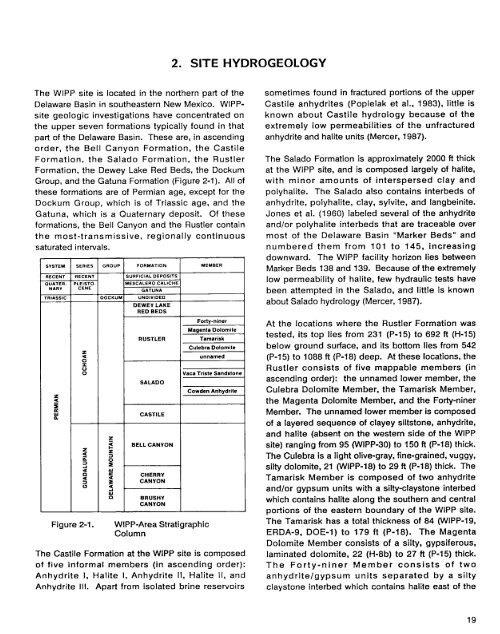Beauheim 1987 - Waste Isolation Pilot Plant - U.S. Department of ...
Beauheim 1987 - Waste Isolation Pilot Plant - U.S. Department of ...
Beauheim 1987 - Waste Isolation Pilot Plant - U.S. Department of ...
Create successful ePaper yourself
Turn your PDF publications into a flip-book with our unique Google optimized e-Paper software.
2. SITE HYDROGEOLOGY<br />
The WlPP site is located in the northern part <strong>of</strong> the<br />
Delaware Basin in southeastern New Mexico. WIPPsite<br />
geologic investigations have concentrated on<br />
the upper seven formations typically found in that<br />
part <strong>of</strong> the Delaware Basin. These are, in ascending<br />
order, the Bell Canyon Formation, the Castile<br />
Formation, the Salado Formation, the Rustler<br />
Formation, the Dewey Lake Red Beds, the Dockum<br />
Group, and the Gatuna Formation (Figure 2-1). All <strong>of</strong><br />
these formations are <strong>of</strong> Permian age, except for the<br />
Dockum Group, which is <strong>of</strong> Triassic age, and the<br />
Gatuna, which is a Quaternary deposit. Of these<br />
formations, the Bell Canyon and the Rustler contain<br />
the most-transmissive, regionally continuous<br />
saturated intervals.<br />
SYSTEM<br />
RECENT<br />
OUATER-<br />
NARY<br />
rRlASSlC<br />
z<br />
5<br />
5<br />
Y<br />
a<br />
-<br />
SERIES<br />
RECENT<br />
'LEISTO-<br />
CENE<br />
Figure 2-1.<br />
FORMATION<br />
iURFlClAL DEPOSITS<br />
IESCALERO CALICHE<br />
GATUNA<br />
UNDIVIDED<br />
DEWEY LAKE<br />
RED BEDS<br />
RUSTLER<br />
SALAD0<br />
CASTILE<br />
BELL CANYON<br />
CHERRY<br />
CANYON<br />
BRUSHY<br />
CANYON<br />
WIPP-Area Stratigraphic<br />
Column<br />
MEMBER<br />
Forfv-niner<br />
Magenta Dolomite<br />
Tamarisk<br />
Culebra Dolomite<br />
unnamed<br />
Vaca Trirte Sandstone<br />
Cowden Anhvdrile<br />
The Castile Formation at the WlPP site is composed<br />
<strong>of</strong> five informal members (in ascending order):<br />
Anhydrite I, Halite I, Anhydrite II, Halite II, and<br />
Anhydrite 111. Apart from isolated brine reservoirs<br />
sometimes found in fractured portions <strong>of</strong> the upper<br />
Castile anhydrites (Popielak et al., 1983), little is<br />
known about Castile hydrology because <strong>of</strong> the<br />
extremely low permeabilities <strong>of</strong> the unfractured<br />
anhydrite and halite units (Mercer, <strong>1987</strong>).<br />
The Salado Formation is approximately 2000 ft thick<br />
at the WlPP site, and is composed largely <strong>of</strong> halite,<br />
with minor amounts <strong>of</strong> interspersed clay and<br />
polyhalite. The Salado also contains interbeds <strong>of</strong><br />
anhydrite, polyhalite, clay, sylvite, and langbeinite.<br />
Jones et al. (1960) labeled several <strong>of</strong> the anhydrite<br />
and/or polyhalite interbeds that are traceable over<br />
most <strong>of</strong> the Delaware Basin "Marker Beds" and<br />
numbered them from 101 to 145, increasing<br />
downward. The WIPP facility horizon lies between<br />
Marker Beds 138 and 139. Because <strong>of</strong> the extremely<br />
low permeability <strong>of</strong> halite, few hydraulic tests have<br />
been attempted in the Salado, and little is known<br />
about Salado hydrology (Mercer, <strong>1987</strong>).<br />
At the locations where the Rustler Formation was<br />
tested, its top lies from 231 (P-15) to 692 ft (H-15)<br />
below ground surface, and its bottom lies from 542<br />
(P-15) to 1088 ft (P-18) deep. At these locations, the<br />
Rustler consists <strong>of</strong> five mappable members (in<br />
ascending order): the unnamed lower member, the<br />
Culebra Dolomite Member, the Tamarisk Member,<br />
the Magenta Dolomite Member, and the Forty-niner<br />
Member. The unnamed lower member is composed<br />
<strong>of</strong> a layered sequence <strong>of</strong> clayey siltstone, anhydrite,<br />
and halite (absent on the western side <strong>of</strong> the WlPP<br />
site) ranging from 95 (WIPP-30) to 150 ft (P-18) thick.<br />
The Culebra is a light olive-gray, fine-grained, vuggy,<br />
silty dolomite, 21 (WIPP-18) to 29 ft (P-18) thick. The<br />
Tamarisk Member is composed <strong>of</strong> two anhydrite<br />
and/or gypsum units with a silty-claystone interbed<br />
which contains halite along the southern and central<br />
portions <strong>of</strong> the eastern boundary <strong>of</strong> the WlPP site.<br />
The Tamarisk has a total thickness <strong>of</strong> 84 (WIPP-19,<br />
ERDA-9, DOE-I) to 179 ft (P-18). The Magenta<br />
Dolomite Member consists <strong>of</strong> a silty, gypsiferous,<br />
laminated dolomite, 22 (H-8b) to 27 ft (P-15) thick.<br />
The Forty-niner Member consists <strong>of</strong> two<br />
anhydritelgypsum units separated by a silty<br />
claystone interbed which contains halite east <strong>of</strong> the<br />
19

















